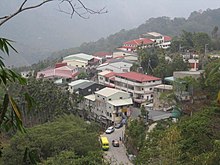Village (Taiwan)
| This article is part of a series on |
| Administrative divisions of Taiwan |
|---|
| Centrally governed |
| Township-level |
| Village-level |
| Neighborhood-level |
|
|
Historical divisions of Taiwan (1895–1945) Republic of China (1912–49) |
Villages are the basic level administrative subdivisions of the Republic of China, under townships, county-administered cities or districts. There are two types of villages depending on the divisions it belongs to.[1]
| Name | Chinese | Mandarin pinyin |
Taiwanese Pe̍h-ōe-jī |
Administered by |
|---|---|---|---|---|
| Urban village | 里 | lǐ | lí | Urban township, County-administered city, District, Mountain indigenous district |
| Rural village | 村 | cūn | chhun | Rural township, Mountain indigenous township |
Structuring and sizing
[edit]The history of villages in Taiwan could date back to the Hoko system in the Japanese era, which ho (保) changed into village after the Republic of China ruled Taiwan. The formation of a village helps divide areas into considerations for transportation and city planning. The formation of the village and its size depend largely on the county it is located in or the population nature of the local area.
In counties or districts with a limited population, 100 households could form a village, whereas in densely populated New Taipei, 1,000 households are necessary to form a village. In very densely populated areas, a village could comprise a population of up to 4,000 households. Thus, the size of villages varies widely.
The following are the statistics of villages in each administrative division in June 2018.
| Region | Township-level divisions |
Village-level divisions |
Types of villages | ||
|---|---|---|---|---|---|
| Urban | Rural | ||||
| Fujian Province | Kinmen County | 6 | 37 | 24 | 13 |
| Lienchiang County | 4 | 22 | 0 | 22 | |
| Kaohsiung City | 38 | 891 | 891 | 0 | |
| New Taipei City | 29 | 1032 | 1032 | 0 | |
| Taichung City | 29 | 625 | 625 | 0 | |
| Tainan City | 37 | 649 | 649 | 0 | |
| Taipei City | 12 | 456 | 456 | 0 | |
| Taiwan Province | Changhua County | 26 | 589 | 264 | 325 |
| Chiayi City | 2 | 84 | 84 | 0 | |
| Chiayi County | 18 | 357 | 89 | 268 | |
| Hsinchu City | 3 | 122 | 122 | 0 | |
| Hsinchu County | 13 | 192 | 96 | 96 | |
| Hualien County | 13 | 177 | 72 | 105 | |
| Keelung City | 7 | 157 | 157 | 0 | |
| Miaoli County | 18 | 275 | 169 | 106 | |
| Nantou County | 13 | 262 | 133 | 129 | |
| Penghu County | 6 | 96 | 34 | 62 | |
| Pingtung County | 33 | 463 | 139 | 324 | |
| Taitung County | 16 | 147 | 61 | 86 | |
| Yilan County | 12 | 233 | 111 | 122 | |
| Yunlin County | 20 | 391 | 164 | 227 | |
| Taoyuan City | 13 | 504 | 504 | 0 | |
| Total | 368 | 7761 | 5876 | 1885 | |
Head
[edit]
The head of a village is elected by the people of the village every four years, the head is subsidized with NT$45,000 per month for local transportation, stationary, postage and bill fees.
The head of a village holds responsibility to initiate and hold meetings, handout certificates of various sorts, encourage bill payments and assist filling out of government documents if required.
See also
[edit]- Notes
- ^ a b c d e f Has an elected executive and an elected legislative council.
- ^ a b c Has an appointed district administrator for managing local affairs and carrying out tasks commissioned by superior agency.
- ^ Has an elected village administrator for managing local affairs and carrying out tasks commissioned by superior agency.
Notes
[edit]- ^ Also known as the Taiwan area or Tai–Min area (Chinese: 臺閩地區; lit. 'Taiwan–Fujian area')
- ^ The mainland area consists of Mainland China, Tibet and (previously) Outer Mongolia
- ^ Special municipalities, cities, and county-administered cities are all called shi (Chinese: 市; lit. 'city')
- ^ Nominal; provincial governments have been abolished
- ^ Constitutionally having the same structure as the free area, these are currently under the Chinese Communist Party control with a different structure
- ^ Sometimes called cities (Chinese: 市) or provincial cities (Chinese: 省轄市) to distinguish them from special municipalities and county-administered cities
- ^ There are two types of townships: rural townships or xīang (Chinese: 鄉) and urban townships or zhèn (Chinese: 鎮)
- ^ Villages in rural townships are known as cūn (Chinese: 村), those in other jurisdictions are known as lǐ (Chinese: 里)
References
[edit]- ^ "Laws and Regulations - Local Government Act". Ministry of the Interior, Republic of China (Taiwan). Archived from the original on 2016-03-15.
